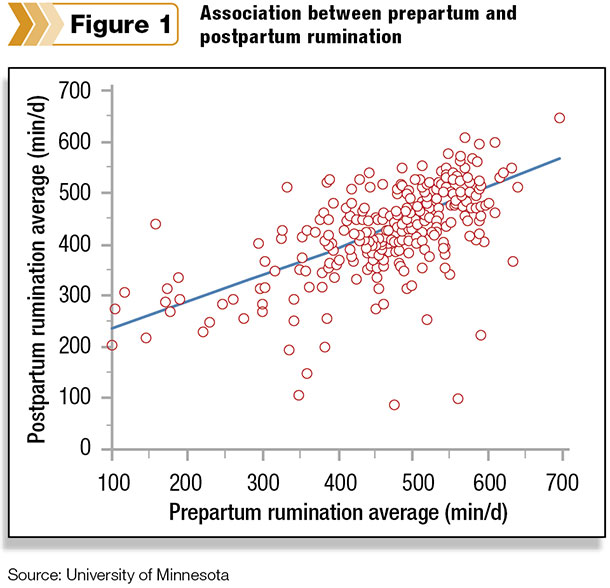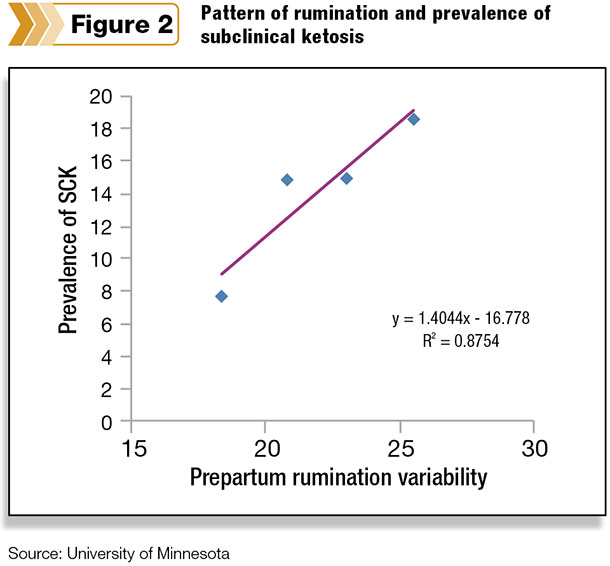Cow 7250 delivered a healthy heifer calf yesterday. Cow 7250 looks good – her eyes look alert, she’s eating fairly well, and she shows no signs of discomfort. Her temperature is normal and, from all outward appearances, she seems ready to begin her next lactation without incident.
Or is she? Two days later, cow 7250 is in the sick pen – listless, ears drooping and off-feed.
Diagnosed with a displaced abomasum, she recovered after surgery and completed her lactation. But her milk production was down by 1,000 pounds from the previous lactation, and her calving interval was extended by several months since her fertility was compromised. The dairy was happy to have saved the cow, but her diminished productivity was a source of frustration.
Dairy personnel thought they knew what was going on inside of 7250, but they were missing a key piece of the puzzle.
What you can’t see
Nobody knew that 7250’s daily rumination levels dropped faster and dipped lower than is typical prior to calving. While rumination levels do decrease during the dry period and especially right before calving, a fast and steep decline is a warning sign of trouble ahead.

Researchers in Italy quantified that cows with lowered rumination times prior to calving had more health problems after calving. Their data show that more than 90 percent of cows in the group with lower rumination time had clinical diseases in early lactation.
They also found that milk yield in early lactation was positively correlated with rumination time.
Trials conducted at the University of Minnesota also demonstrate the correlation of rumination time pre- and post-calving: Cows with higher rumination levels before calving have higher rumination levels after calving. And that higher level of rumination generally results in improved animal health and performance.
While it’s not possible to note exactly which malady afflicts an animal, the Minnesota data does show a clear correlation between prepartum rumination and transition health disorders.
Figure 2 shows the rumination time for cows later diagnosed with subclinical ketosis.

The figure shows the variability of rumination before calving and the likelihood of developing that disease after calving. In other words, cows that have lower rumination variability pre-calving have lower chance to develop subclinical ketosis.
Cows with higher variability pre-calving have higher chance to develop that disease. That’s why it’s recommended to avoid changes or things that can negatively affect the level of rumination. It’s important to keep rumination as steady as possible.
If rumination variability increases, the key is to quickly identify those animals in need of an intervention so preventative measures can be taken.
Getting to ‘I know’
Experience and intuition are vital components of good animal husbandry. Most dairy producers are very good at identifying cows showing visual signs of needing a health intervention. But animal monitoring technology allows you to do even better. You can manage from a position of “I know” versus “I think this is what’s happening” with an individual cow or within a group or your entire herd.
That’s because unlike animal monitoring technology, people are unlikely to identify issues before those clinical signs appear.
For example, research conducted by Cornell University and presented at the 2015 American Dairy Science Association annual meeting demonstrated that rumination monitoring technology accurately identified displaced abomasum as early as three days before cows were identified by highly skilled dairy employees.
Further, the rumination monitoring technology identified cases of ketosis about two days prior to physical symptoms and found cases of indigestion nearly a day before physical symptoms appeared.
In addition, most people cannot readily pinpoint the depth of nutritional, housing or other management changes. Animal monitoring technology can help troubleshoot the origins of management challenges.
For instance, a 4,000-cow California dairy learned that animal monitoring in the dry period and fresh pen meant dairy personnel were able to target animals with lowered rumination levels with physical exams and intervene as necessary.
This protocol change dramatically reduced lockup time in the fresh pen – from three to four hours a day to 30 to 45 minutes a day. Not only did the operation reduce treatment cost since fewer animals required attention, the entire group gained in health status since cows had more time for resting and other beneficial behaviors. In other words, the cows had more time to do what came naturally – eating and lying.
The healthier cows milked more, and the herd’s pregnancy rate rose from 22 percent to 26 percent because dairy personnel no longer had to rely on what they thought was going on with the cows. They had reliable data to make more informed management decisions, which resulted in improved animal health, care and productivity.
Benefits gained
Ultimately, rumination monitoring technology elevates dairy management to a new level where early recognition of these opportunities is possible. The result is similar to how dairy producers were able to significantly improve milk production once the key milk production traits were identified – rumination technology improves producers’ abilities to recognize and then manage health and performance challenges because they can be defined and pinpointed.
Instead of thinking they understand what is occurring within an animal, producers can use data and technology to know what’s happing in their herds. As people manage herds differently, animal monitoring technology is a positive example of how this data benefits dairies of all sizes while improving cow health and on-farm care. PD
References omitted due to space but are available upon request. Click here to email an editor.
Gláucio Lopes is a veterinarian, graduated from Brazil and received his master’s degree in dairy cow reproduction at the University of Wisconsin – Madison. He is the large herd manager and reproduction specialist for SCR Dairy Inc.

-
Gláucio Lopes
- Large-Herd Manager
- Repro Specialist
- SCR Dairy Inc.
- Email Gláucio Lopes






